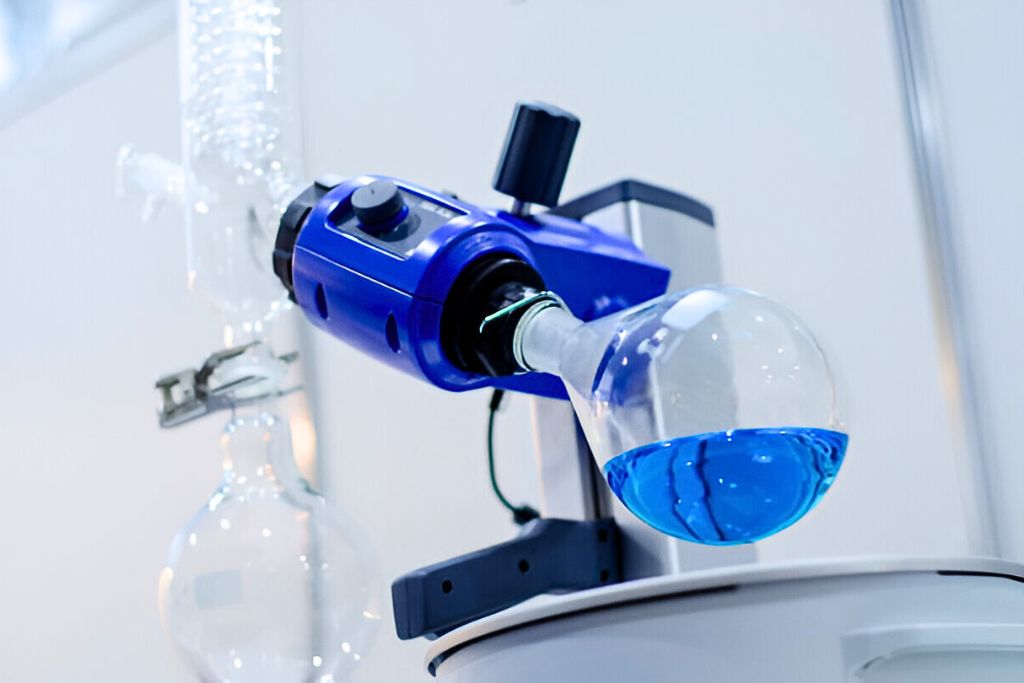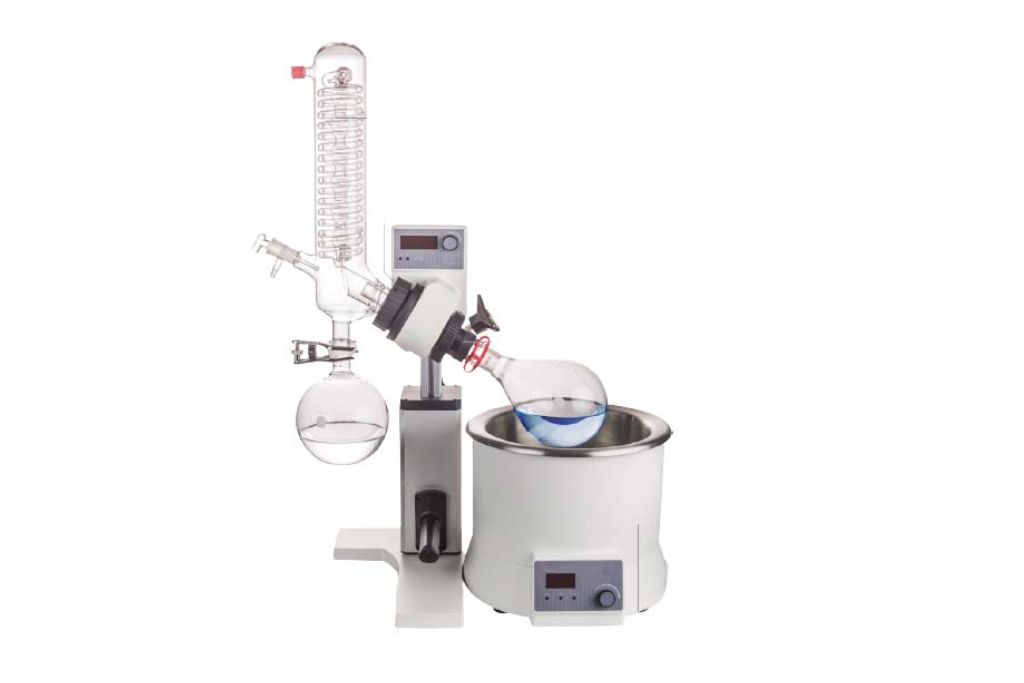Digital rotary evaporators are important tools in modern laboratories that enhance the distillation process. These devices efficiently separate solvents from mixtures, making them essential in fields like pharmaceuticals and biotechnology.
Digital rotary evaporators significantly improve the accuracy and speed of solvent removal by operating under reduced pressure and precisely controlling temperature.
You will find that these instruments offer a range of applications, from extracting active ingredients in drug formulation to concentrating essential oils in the fragrance industry.
The advancements in digital technology have made them more user-friendly and efficient, allowing for better results with less effort. Understanding how to use and maintain these systems can greatly benefit your research or production work.
Key Takeaways
- Digital rotary evaporators enhance the efficiency of solvent distillation.
- They serve various applications across multiple scientific fields.
- Technological advancements improve their usability and effectiveness.
Basic Principles of Digital Rotary Evaporators
Digital rotary evaporators work through a combination of mechanical and thermal processes designed for efficient solvent removal. Understanding their operational mechanics and the processes of evaporation and condensation is essential for effective use.

Operational Mechanics
A digital rotary evaporator consists of several key components: a rotating flask, a vacuum system, a heating bath, and a condenser. The rotating flask holds the sample solution, while the vacuum system lowers the pressure inside, facilitating solvent evaporation at a lower temperature.
When you set the temperature on the digital display, the heating bath gently warms the flask. As the flask rotates, it increases the surface area of the solution, allowing for more efficient solvent evaporation. This continuous rotation ensures that the solvent does not overheat or decompose.
Evaporation and Condensation Processes
Evaporation and condensation are crucial in achieving efficient solvent recovery. Evaporation occurs in the rotating flask when the solvent converts from liquid to vapor. With reduced pressure in the system, this transition happens at lower temperatures, protecting sensitive compounds.
The vapor then travels into the condenser, where it meets a cooling coil. As the vapor cools, it condenses back into a liquid. The liquid is then collected in a separate receiving flask. Proper control of temperature and vacuum pressure is vital, ensuring maximum evaporation efficiency while preventing contamination of the sample.
By understanding these principles, you can optimize the operation of your digital rotary evaporator for better results.
Applications in Laboratory Settings
Digital rotary evaporators are versatile tools widely used in laboratories for various applications. These instruments help optimize processes, providing efficient and gentle methods for handling samples and solvents.
Sample Concentration
In laboratory settings, your primary use of a digital rotary evaporator is for sample concentration. This process involves reducing the volume of a solution by evaporating its solvent while preserving the sample’s integrity.
By employing reduced pressure, the boiling point of the solvent decreases. This allows you to concentrate sensitive compounds that may degrade under high temperatures.
The evaporation occurs as the sample rotates in a heated bath, which ensures even heating and minimizes localized overheating. This is especially crucial when dealing with delicate substances, such as natural extracts and pharmaceutical compounds.
The ability to concentrate samples effectively expands your research capabilities and leads to more accurate analysis.
Solvent Removal
Removing solvents from solutions is another essential application of digital rotary evaporators. This process is vital when you need to isolate specific compounds after chemical reactions or extractions.
You can set specific parameters, such as temperature and speed, to suit the characteristics of the solvent used. For instance, volatile solvents like ether can be removed efficiently without affecting the sample’s components.
As the solvent evaporates, it can be collected and condensed, allowing for efficient recovery. This method is crucial in experiments where solvent disposal is a concern, promoting environmental sustainability in your lab practices.
Solvent Recycling
Solvent recycling is increasingly important in modern laboratories due to environmental and cost considerations. Using a digital rotary evaporator, you can recover solvents for reuse.
By effectively separating solvents from your samples, you can collect pure solvents that can be stored for future experiments. This not only reduces waste but also cuts down on the costs of purchasing new solvents.
Employing this method enhances your lab’s sustainability efforts and promotes efficient resource use. You will find that implementing solvent recycling methods benefits both your research and the environment.
Technological Advancements
Modern digital rotary evaporators have incorporated significant technological innovations. These improvements include advanced digital interfaces and automated control systems, enhancing user experience and efficiency in laboratory settings.

Digital Interface
The digital interface in rotary evaporators allows you to easily monitor and control various parameters. You can set precise temperatures, rotation speeds, and vacuum levels with just a few clicks. These displays often feature touchscreen capabilities, making them user-friendly.
Many models also offer data logging features. This means you can record your experiments and refer back to them later. Some interfaces allow for remote monitoring via smartphones or computers, increasing flexibility and control over your process.
Using a digital interface not only improves accuracy but also reduces the likelihood of human error. Consequently, this advancement contributes to more reliable and reproducible results in your work.
Automated Control Systems
Automated control systems represent another crucial advancement in digital rotary evaporators. These systems enable you to program and automate various functions, allowing for consistent performance throughout your experiments.
With automated control, tasks like adjusting pressure and temperature occur without constant user input. This system helps to minimize manual intervention, which can lead to mistakes. You can also customize your protocols for different experiments.
Many automated models integrate safety features as well, such as automatic shutdown during system failures. This ensures that your samples remain safe and protected. The efficiency gained through automation can significantly enhance productivity in your laboratory.
Frequently Asked Questions
This section addresses common inquiries about digital rotary evaporators, focusing on their applications, functions, advantages, and pricing factors. You will also learn about the specific extraction methods they facilitate and when rotary evaporation is most beneficial.
What are the applications of a digital rotary evaporator in industrial processes?
Digital rotary evaporators are widely used in various industrial processes. They excel in concentrating and purifying essential oils, pharmaceuticals, and food extracts. Additionally, they help in the recycling of solvents, which is crucial for reducing waste in manufacturing.
How does a rotary evaporator function in a laboratory setting?
In a laboratory, a rotary evaporator works by gently heating a liquid and placing it under reduced pressure. The vaporized solvent is then cooled and condensed back to a liquid, allowing for efficient solvent removal. This process is essential for purifying compounds without damaging them.
What are the primary advantages of utilizing a digital rotary evaporator?
Utilizing a digital rotary evaporator offers several advantages. They provide precise temperature control, ensuring safe processing of sensitive materials. Additionally, their automated features help reduce manual labor, increasing efficiency and allowing for consistent results in various applications.
In which scenarios is rotary evaporation the preferred method?
Rotary evaporation is preferred for processes requiring the gentle removal of solvents. It’s especially useful in fields like pharmaceuticals and food science, where preserving the integrity of heat-sensitive compounds is crucial. It’s also beneficial for large-scale extractions and when speed is necessary.
Can you detail the extraction methods facilitated by a rotary evaporator?
Rotary evaporators facilitate several extraction methods, including solvent-based and steam distillation. They are widely used for extracting essential oils, concentrated flavors, and active pharmaceutical ingredients. These methods help achieve high purity levels and preserve desirable characteristics of the extracted substances.
What factors influence the price of a rotary evaporator?
The price of a rotary evaporator is influenced by various factors, such as size, brand, and features. High-end models may include advanced controls and automation features, which can increase costs. Additionally, the materials used in construction and overall durability also play a significant role in pricing.